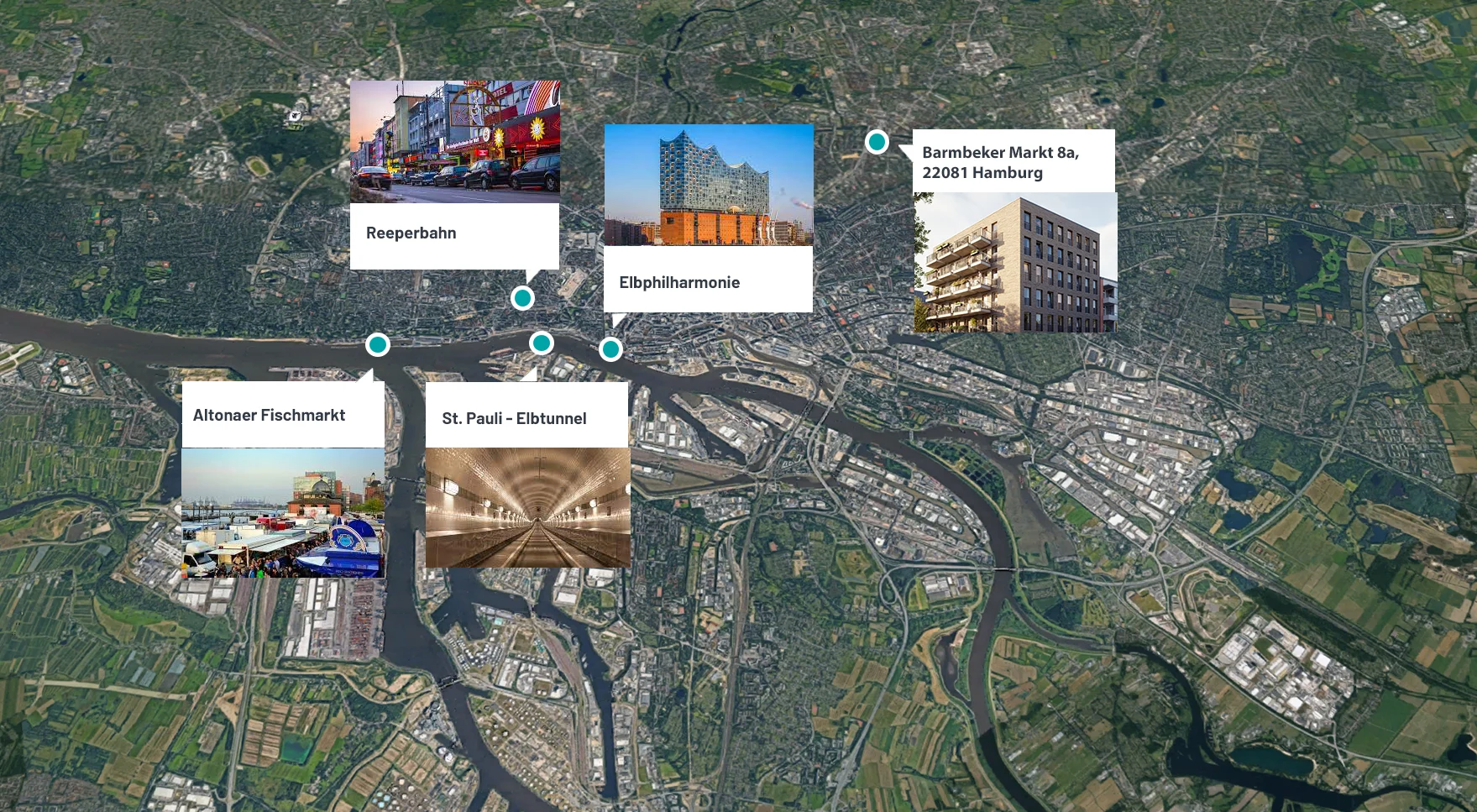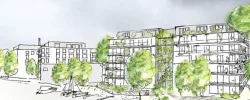Barmbeker Markt 8a
Return
7.75% p.a.
Duration
30 months
Project type
Growth
Distribution
Yearly
Notice according to § 12 (2) Vermögensanlagengesetz
This investment involves considerable risk and may result in partial or total loss.Project Presentation
The property "Barmbeker Markt 8a" is a new construction project in Hamburg, whereby around 1,457 m² of space is to be created. The property is located in a very good location, which has a sustained high demand for residential real estate. In the course of the project, which has already received building permission, a new construction project with a total of 35 residential units and one commercial unit is to be created.
The property is located in one of the most populous cities in Germany and has one of the busiest ports in Europe. Local suppliers of all kinds are located in the immediate vicinity of the property and leave nothing to be desired by residents. The breathtaking city center of Hamburg can be reached in less than 20 minutes.
The purchase contract has been concluded and the issuer is the owner of the property. A land register entry is available. A building permit has also been obtained and the project will start in the 3rd quarter of 2022.
Location
Welcome to Hamburg
The Hanseatic City of Hamburg is the second smallest of Germany's 16 federal states, covering an area of just 755 square kilometers. It is also the most populous city in Germany after Berlin and has one of the largest and busiest ports in Europe. The official name, which includes both the state and the city, reflects Hamburg's long tradition of particularism and self-government. Hamburg and Bremen (the smallest of the states) are the only German city-states that still retain some of their medieval independence. Hamburg's characteristic individuality has been proudly cultivated by its citizens, so that the city's culture has retained its uniqueness in many areas of public and private life and has not succumbed to the general trend toward standardization.
Microlocation Barmbeker Markt
Barmbek-Nord is a district in the Hamburg-North district of the Free and Hanseatic City of Hamburg. Until 1951, it formed the district of Barmbek together with Barmbek-Süd and Dulsberg. In Barmbek, you will meet students, young families and old-established residents of the neighborhood, who make the former working-class district a lively and authentic corner of Hamburg. The property Barmbeker Markt 8a is ideally connected by the subway station "Dehnhaide", which is only a 3-minute walk away. So it is possible to get into Hamburg's transport network in an uncomplicated way.
Discover the surroundings
The project "Barmbeker Markt 8a" is located in the Hamburg district of Barmberk-Nord. This is a district in the Hamburg-Nord district of the Free and Hanseatic City of Hamburg. Until 1951 it formed the district of Barmbek together with Barmbek-Süd and Dulsberg. In Barmbek, you will meet students, young families and old-established residents of the neighborhood, who make the former working-class district a lively and authentic corner of Hamburg. The property Barmbeker Markt 8a is ideally connected by the subway station "Dehnhaide", which is only a 3-minute walk away. This makes it possible to get into Hamburg's transport network in an uncomplicated way.
The bridges of Hamburg
With about 2500 bridges, the city is considered one of the most bridge-rich in Europe. This high number is due to the city's location in the inland delta of the Elbe River and the lowlands of the Alster and Bille Rivers, along with numerous tributaries, canals and canals. In addition, there is the expansion of the harbor and its connection to a dense road and rail network that bridges the many waterways. Another special feature is the subway, which was developed as an elevated railroad and runs for the most part above ground and thus over numerous bridges through the city. The actual number of bridges is not known. Counting bridges is considered difficult because different definitions of a bridge exist. According to the Hamburg State Office for Roads, Bridges and Waterways, a vehicle bridge is defined as anything with a clear width of at least two meters, and a pedestrian bridge is defined as anything with a span of at least five meters. However, if an overpass is more than 80 meters wide, it is a tunnel. Deutsche Bahn, on the other hand, defines anything with a span of more than two meters as a bridge, so that includes larger signal cantilevers over tracks.
Musicals
Hamburg is - by some distance - the world's third-largest location for musicals after New York and London and counted two million musical visitors in 2007. With the Operettenhaus, the "Neue Flora", the Theater im Hafen and the Theater an der Elbe, Stage Entertainment maintains four larger musical theaters with an audience capacity of between 1400 (Operettenhaus) and 2030 (Theater im Hafen) seats, as well as the "Theater Kehrwieder" (up to 320 seats) in the Speicherstadt, where musicals, vaudeville or cabaret, among other things, are occasionally presented. The old warehouse also houses the Stage Entertainment Studios and the Joop van den Ende Academy, which specializes in musical training. The Stage School, which has been in existence since 1985, also trains performers for this field.
Altona Fish Market
The Altona Fish Market is a public market in Hamburg's Altona-Altstadt district. Its history is embedded in the competition between the two rival cities of Altona and Hamburg. It is now marketed as a tourist attraction, but still has an economic function. Originally, the market held in Altona served to supply the citizens with fresh fish. Since the early 18th century, fruit, vegetables and plants have also been sold at the Altona fish market. The peculiarity of also being open early on Sundays, however, is due to the fact that the fish landed with the fishing boats was to be sold in the morning before going to church, in order to get it as fresh as possible into the manorial kitchens. On a map of 1770 "Grund-Riss der Stadt Altona" the fish market is marked with the letter "A" at the point where the then "Elbstraße" and the "Kleine Elbstraße" meet.
As early as 1846, a track of the Altona Port Railway led from the Altona train station over the Geesthang, initially with a cable elevator, and from 1876 through the Schellfischtunnel to the fish market. At times, the largest transshipment of sea fish and canned fish from the canning industry located in the fish market area for the German inland areas took place here. The tunnel is now closed, but can be visited with accompanying guides. Nowadays, the offer is no longer limited to food. Technical accessories or tourist souvenirs are also offered; live chickens, carrier pigeons and rabbits are part of the traditional offer. After shopping, visitors can listen to jazz or rock music in the adjacent fish auction hall.
As of March 15, 2020, the fish market was cancelled by the relevant authorities for the first time in its 300-year history due to the onset of the Corona pandemic. Although hygiene concepts were drawn up for reopening, the market with its last 120 or so market stalls still remained closed a year later.
Elbphilharmonie
The Elbphilharmonie (also known as "Elphi" for short) is a concert hall in Hamburg that was completed in November 2016. It was planned with the aim of creating a new landmark for the city and a "cultural monument for all". The 110-meter-high building in the HafenCity district is located on the right bank of the Norderelbe at the tip of the Großer Grasbrook between the mouths of the Sandtorhafen and Grasbrookhafen harbors. It was built incorporating the shell of the former Kaispeicher A (built in 1963). A modern structure with a glass façade reminiscent of sails, water waves, icebergs or a quartz crystal was placed on this base. The location at Kaiserhöft is influenced by the former industrial use of the harbor and the neo-Gothic brick architecture of the Speicherstadt.
The concept of the concert hall goes back to an idea presented in 2001 by the Hamburg project developer Alexander Gérard. Construction was then approved by the city's parliament under Mayor Ole von Beust in 2007. The design and planning of the philharmonic hall were mainly the work of the Basel-based architectural firm Herzog & de Meuron. The client was Elbphilharmonie Bau KG, of which the Free and Hanseatic City of Hamburg is a partial shareholder and main financier with tax funds. The building was erected on its behalf by construction services provider Hochtief.
Completion of the building was scheduled for 2010 after several years of preparation, but was delayed several times, partly due to a one-and-a-half-year construction stop in the public sector. Construction only continued after a comprehensive project reorganization between the architects, the client and the construction company shortly after the election of Mayor Olaf Scholz. Due to the delays and the fact that the originally estimated construction costs were exceeded, the Elbe Philharmonic Hall became known throughout Germany long before its completion: Construction costs ended up at around 866 million euros, slightly more than 11.24 times the sum originally planned at 77 million euros. The date agreed in the new contract for the handover of construction and keys on October 31, 2016 was met. The inauguration of the concert area was celebrated on January 11 and 12, 2017 with the concert "Zum Raum wird hier die Zeit" by the NDR Elbphilharmonie Orchestra (concert program). The Small Hall was inaugurated by Ensemble Resonanz on January 12, 2017. In the first year after its opening, around 850,000 people attended the more than 600 concerts in the Elbphilharmonie, over 4.5 million visitors made a pilgrimage to the Plaza, more than 70,000 people took part in guided tours of the concert hall and over 60,000 in the building's music education program.
St. Pauli Elbtunnel
Opened in 1911, the St. Pauli Elbtunnel - also known as the Alter Elbtunnel to distinguish it from the New Elbtunnel, which has existed since 1975 - passes under the North Elbe River over a length of 426.5 meters and connects the northern edge of the harbor at the St. Pauli Landungsbrücken (north entrance) with the Elbe island of Steinwerder (south entrance) with two tunnel tubes. It is used as a public transport route by pedestrians and cyclists as well as by motor vehicles to a limited extent. It was considered a technical sensation when it was opened, has been a listed building since 2003 and was awarded the title of Historic Landmark of Civil Engineering in Germany by the Federal Chamber of Engineers and the Hamburg Chamber of Civil Engineers on September 7, 2011. The honorary plaque was placed at the northern entrance (St. Pauli).
Reeperbahn
The Reeperbahn is the central street in the entertainment and red light district of Hamburg's St. Pauli district. It is about 930 meters long and runs from Millerntor westward to Nobistor (Hamburg-Altona), where it merges with Königstraße. The large number of bars, nightclubs and discos, but especially the red-light district concentrated on and around the Reeperbahn, has earned it the nickname "the most sinful mile in the world".

Team
Rock Invest GmbH & Co. KG is an investment company with over 20 years of experience in the Central European real estate market. With approximately 200,000 m² of leasable space under development and 100,000 m² of existing properties in Europe's top metropolises, our total portfolio will reach a volume of 1 billion € in 2022.
Rock Invest is one of the leading development companies in Europe. We have created an investment platform for German and international institutional investors, offering a broad product range in the Living & Hospitality sector with a holistic investment approach.



